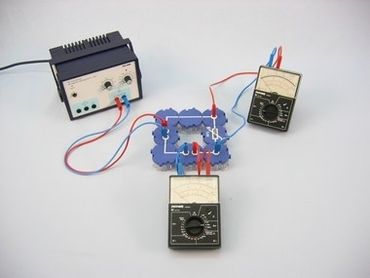The NTC resistor  ![]() Principle In connection with Ohm's Law, the students have already learned that metallic conductors generally have a resistance which increases with increasing temperature.
Now, they should discover that the opposite is true for NTC resistors (Negative Temperature Coefficient). The first experiment does not just serve as an introduction to this topic. It is also useful in demonstrating the terms self-heating (in the first experiment) and external heating (in the second experiment). The second experiment should be used to confirm these concepts. Benefits - No additional cable connections between the building blocks needed - clear arragned and quick setup
- Contact saftey due to puzzle blocks system
- Corrosion-free gold plated contacts
- Doubled earning sucess: Electric circuit diagram on top, real components can be seen unterside
Tasks Does the resistance of certain components decrease with an increase in temperature? Determine whether and how the resistance varies depending on temperature using an NTC resistor. Scope of delivery |
Straight connector module, SB
|
05601-01
|
1
| |
Angled connector module, SB
|
05601-02
|
2
| |
Interrupted connector module with sockets, SB
|
05601-04
|
2
| |
Angled connector module with socket, SB
|
05601-12
|
2
| |
Socket module for incandescent lamp E10, SB
|
05604-00
|
1
| |
NTC-resistor module, SB
|
05630-01
|
1
| |
Connecting cable, 32 A, red, various lengths
|
07360-01
|
1
| |
Connecting cable, 32 A, blue, various lengths
|
07360-04
|
1
| |
Connecting cable, 32 A, red, various lengths
|
07361-01
|
2
| |
Connecting cable, 32 A, blue, various lengths
|
07361-04
|
2
| |
Filament lamps 4V/0.04A, E10, 10
|
06154-03
|
1
| |
PHYWE Analog multimeter, 600V AC/DC, 10A AC/DC, 2 MΩ, overload protection
|
07021-11
|
2
| |
PHYWE Power supply, 230 V, DC: 0...12 V, 2 A / AC: 6 V, 12 V, 5 A
|
13506-93
|
1
|
|



